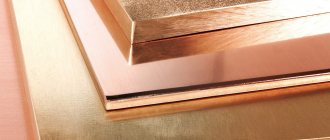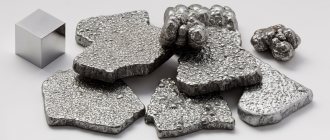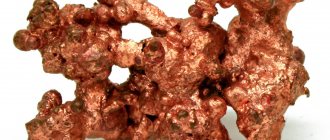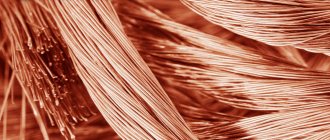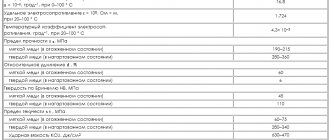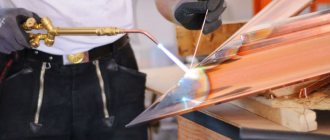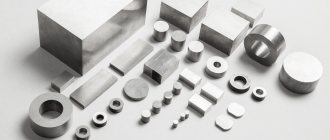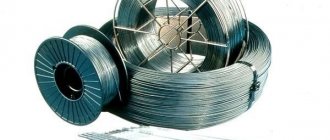From the school chemistry course, we all know well that copper is red in color, and if you look closely at the fracture of this metal, you can see that inside it has a pinkish tint. The beautiful color of the surface is not the only advantage of this metal, which modern industry produces in several grades (M00, M0, M1, M2, M3). Copper, used by mankind since ancient times, is characterized by a fairly high density, low resistivity, and exceptional electrical and thermal conductivity.
Copper rods
Copper
Copper is a mineral from the class of native elements.
Fe, Ag, Au, As and other elements are found in natural minerals as impurities or forming solid solutions with Cu. The simple substance copper is a ductile transition metal of golden-pink color (pink in the absence of an oxide film). One of the first metals widely mastered by man due to its relative availability for extraction from ore and low melting point. It is one of the seven metals known to man since very ancient times. Copper is an essential element for all higher plants and animals.
History of copper
Humanity began mining copper several thousand years ago. The most ancient products found from this metal date back to the 7-6 centuries BC. Among them are jewelry, tools, dishes and tools.
A big step forward in the development of metallurgy was the discovery of an alloy of copper and tin - bronze. This material was distinguished by its increased strength and ability to forge, due to which all products made from this copper alloy were of higher quality.
In our country, copper has long been mined in the Urals, Altai and Siberia. The most famous cultural monuments were cast from it: the Tsar Cannon, the Tsar Bell, the Bronze Horseman.
Metal mining
In nature, copper in the form of nuggets is more common than gold, silver or iron. The oldest copper objects, as well as slag, indicating its smelting from ore, were discovered in Turkey during excavations of ancient settlements. It is known from history that the Stone Age was followed by the Copper Age, characterized by the manufacture and use of copper objects. Research by scientists suggests that even with the softness of the metal, tools made of copper are superior to stone products in the speed of planing, chopping, drilling and sawing wood. Copper ores are mineral deposits that contain not only copper, but also other substances that contribute to their properties, such as nickel. Copper ores are considered to be those types of ores in which the copper content would be sufficient for reasonable extraction by industrial methods. These requirements are met by ores containing non-ferrous metal in the range from 0.5 to 1%. The Earth has copper-bearing resources, 90% of which are copper-nickel ores.
Ore is now mined in a number of countries, but the largest deposits are found in Australia, Chile, Indonesia, and the USA. In recent years, the continuous process of mining this metal has noticeably decreased. This is due to the widespread use of scrap (raw materials) in industry.
Due to the strength of the metal and the ability to retain its physical and chemical properties for a long time, the life cycle of copper is quite long, although products become unusable over time. They are handed over to metal collection points, and a new process of processing copper scrap begins, consisting of several stages and having a positive effect on the economics of production. At the same time, the bowels of the earth remain untouched; moreover, processing ore requires considerable energy expenditure, and 90% less is spent on processing scrap. Not all metals are characterized by such a high indicator.
Copper belongs to the group of non-ferrous metals, even the ore has a distinct copper color. Ore is mined mainly by open-pit mining, that is, without mine structures, and the metal is extracted using beneficiation using the flotation method. The ore rock is wetted with water, non-metallic substances are moistened and stick together, forming waste, and non-wetted particles rise up and form foam. Then the copper ore undergoes an additional purification cycle, is sent to the smelting furnace, and then to the production of blanks.
Copper hair
Girls who have their own copper hair color can have shades from light to cognac. Plus they are very beautiful. What color is copper and where does this color come from? The copper color is obtained due to the large amount of pheomilanin in the hair follicles. It has long been believed that only the Scots and Irish have a copper and red hue from birth. But with the frantic pace of technology, such a shade can now be easily obtained by purchasing hair dye. Cosmetic companies offer a huge selection of hair dyes of varying durability and tonal color.
Characteristics and features
Copper appears as a golden-pink metal, which when exposed to air acquires an oxide coating of a yellowish-red hue. Just like gold, cesium and osmium, it is characterized by individual coloration. There are some other features of the metal:
- It has a high degree of electrical conductivity (in second place after silver), especially when used in its pure form. The admixture of other metals or any substances in the composition reduces its conductivity.
- The metal is strong and durable, therefore it is widely used in the production of pipes and roofing materials.
- The attractive color and shine of copper made it possible to use it for making dishes, various decorative items, objects and interior decorations.
- An important feature of copper is the oxidation process. When interacting with a humid environment, the metal acquires a unique coating. Thanks to the patina layer, the metal is protected from corrosion and various damages. This property of copper is often used by artists and sculptors. By artificially exposing the metal to moisture, an unusual color of the product is obtained. An example is the Statue of Liberty in the USA. Over the years, a patina began to form on it, and the monument acquired a green tint. Now Americans call their symbol “Green Lady.”
- It is highly energy efficient. The good thermal conductivity of the metal allows for significant energy savings. If the heating system is equipped with insulated copper pipes, heat loss is reduced many times. Conversely, in cooling systems, the metal maintains the set temperature.
- This is an essential trace element involved in many processes of the human body: hematopoiesis, sugar and cholesterol metabolism, promotes the absorption of iron, improves the functioning of the cardiovascular system and brain.
Many foods are rich in this metal. The daily dose required for the normal functioning of the body is from 1.5 to 3 mg per day. It must be borne in mind that an insufficient amount has a detrimental effect on the human body.
PROPERTIES
Copper is a golden-pink ductile metal; in air it quickly becomes covered with an oxide film, which gives it a characteristic intense yellowish-red hue. Thin films of copper have a greenish-blue color when exposed to light.
Along with osmium, cesium and gold, copper is one of the four metals that have a distinct coloration that is different from the gray or silver of other metals. This color tint is explained by the presence of electronic transitions between the filled third and half-empty fourth atomic orbitals: the energy difference between them corresponds to the wavelength of orange light. The same mechanism is responsible for the characteristic color of gold.
Copper has high thermal and electrical conductivity (it ranks second in electrical conductivity among metals after silver). Specific electrical conductivity at 20 °C: 55.5-58 MS/m. Copper has a relatively large temperature coefficient of resistance: 0.4%/°C and is weakly dependent on temperature over a wide temperature range. Copper is diamagnetic.
There are a number of copper alloys: brass - with zinc, bronze - with tin and other elements, cupronickel - with nickel and others.
RESERVES AND PRODUCTION
The average copper content in the earth's crust (clarke) is (4.7-5.5) 10−3% (by mass). In sea and river water the copper content is much lower: 3·10−7% and 10−7% (by weight), respectively. Most copper ore is mined by open pit mining. The copper content in the ore ranges from 0.3 to 1.0%. World reserves in 2000 were, according to experts, 954 million tons, of which 687 million tons were proven reserves; Russia accounted for 3.2% of total and 3.1% of confirmed world reserves. Thus, at the current rate of consumption, copper reserves will last approximately 60 years. Copper is obtained from copper ores and minerals. The main methods for obtaining copper are pyrometallurgy, hydrometallurgy and electrolysis. The pyrometallurgical method involves obtaining copper from sulfide ores, for example, chalcopyrite CuFeS2. The hydrometallurgical method involves dissolving copper minerals in dilute sulfuric acid or ammonia solution; From the resulting solutions, copper is replaced by metallic iron.
APPLICATION
Due to its low resistivity, copper is widely used in electrical engineering for the manufacture of power cables, wires or other conductors, for example, in printed circuit wiring. Copper wires, in turn, are also used in the windings of energy-saving electric drives and power transformers. Another useful quality of copper is its high thermal conductivity. This allows it to be used in various heat removal devices and heat exchangers, which include well-known radiators for cooling, air conditioning and heating. Alloys using copper are widely used in various fields of technology, the most widespread of which are the above-mentioned bronze and brass. Both alloys are general names for a whole family of materials, which in addition to tin and zinc may include nickel, bismuth and other metals. In jewelry, alloys of copper and gold are often used to increase the resistance of products to deformation and abrasion, since pure gold is a very soft metal and is not resistant to these mechanical influences. The predicted new mass use of copper promises to be its use as bactericidal surfaces in medical institutions to reduce intra-hospital bacterial transfer: doors, handles, water stop valves, railings, bed rails, table tops - all surfaces touched by the human hand.
PHYSICAL PROPERTIES
| Mineral color | copper-red, fading to black or green in air |
| Stroke color | copper red |
| Transparency | opaque |
| Shine | metal |
| Cleavage | No |
| Hardness (Mohs scale) | 2,5-3 |
| Strength | malleable |
| Kink | jagged |
| Density (measured) | 8.94 - 8.95 g/cm3 |
| Radioactivity (GRapi) | 0 |
| Magnetism | diamagnetic |
OPTICAL PROPERTIES
| Color in reflected light | pinkish white |
| Pleochroism | does not pleochroate |
| Luminescence in ultraviolet radiation | not fluorescent |
CRYSTALLOGRAPHIC PROPERTIES
| Point group | m3m (4/m 3 2/m) - hexoctahedral |
| Space group | Fm3m (F4/m 3 2/m) |
| singonia | cubic |
| Cell Options | a = 3.615Å |
| Morphology | cubes, dodecahedrons and tetrahexahedrons; rarely octahedra and complex combinations; thread-like, tree-like |
| Twinning | {111} twins according to the spinel law |
Benefits of Copper
- High anti-corrosion properties;
- Aesthetically attractive appearance;
- High thermal conductivity;
- Good indicators of flexibility and ductility while maintaining strength;
- Low level resistance.
Flaws
High price. The main (conditional) disadvantage of copper can be considered the rather high cost of the material.
Richness of primary color and variety of shades
Until recently, technological capabilities did not make it possible to immediately obtain copper of the desired color and the roofs of houses were covered with the classic yellow-shiny metal. Over time, as metal oxide formed on the surface of the metal, the roof took on a darker hue. Further chemical processes occurring in copper, which actively interacted with the environment, led to the formation of a layer of malachite-green patina on its surface.
Patina, along with the painting of roofs, reliably protects them from corrosion. Copper roofs covered with such a film can last for decades without losing their performance characteristics.
Nowadays, using photos in the catalogs of specialized stores, you can immediately choose what color copper sheets to use to cover the roof of your house. The capabilities of modern technologies make it possible to immediately obtain classic, oxidized or patinated copper.
Nowadays, not only the roofs of houses, but also their facades are covered with copper of different colors. It should be noted that this is not only beautiful, but also profitable from a financial point of view. The copper sheets with which the facade of the house is finished do not require special care and do not fade over time, reliably protecting building structures from the negative effects of temperature changes and high humidity.
Copper oxide and sulfate, which are actively used in modern industry, also have interesting colors. Copper oxide, whose crystals are black, is used to impart various shades (blue, green) to glass and paints and varnishes. Copper sulfate is not used as a dye, but still has a beautiful blue-turquoise color.
Color coordinates
- HEX: #b87333
- RGB: 184, 115, 51
- HSV: 29°, 72%, 72%
Natural color standard - copper
The photo shows copper in processed form and in its natural state - a nugget.
Copper alloy colors
Copper alloys, the most famous of which are bronze and brass, have colors similar to the base metal.
- Bronze is an alloy of copper, the main alloying element in which is tin. The color of this alloy can vary from slightly golden to coppery red. Bronze, due to its beautiful color and ease of processing, is actively used for the manufacture of artistic forms and decorative elements, as well as for the production of products of practical importance.
- Brass is an alloy of copper and zinc. Products made from brass have a beautiful golden color. In addition to its beautiful color, this alloy has exceptional corrosion resistance, good ductility and high strength, which allows it to be used for the production of plumbing fixtures, parts for various equipment, as well as products for any other purpose.
How to distinguish copper by eye
Visual examination of a non-ferrous metal or alloy is not the most effective method for identifying copper. It is sufficient to distinguish copper from aluminum, nickel and zinc.
The natural color of copper is red-pink, without distortion it is easy to determine in natural light. This is important to consider because artificial light can give the metal a yellowish-green tone.
During visual examination, it is necessary to remove the oxide from the metal. This is easy to do by treating the surface of the product with a file or cutting it.
It is difficult to distinguish copper from bronze and brass, as well as from copper-plated aluminum. At receiving points, copper is valued more expensive than bronze, aluminum and brass. For this reason, it is necessary to be able to accurately identify this non-ferrous metal in various ways.
Methods for determining bronze and aluminum
It is not always possible to determine the type of metal by color. For example, bronze is an alloy of copper and tin and also has a rose-red hue. Therefore, you need to use the plasticity testing method. When pressing on copper with a hard object, a notch will remain on the surface; bronze will not be deformed during such manipulation.
You can distinguish copper from bronze using a salt solution. Dissolve 200 g of salt in one liter of water, pour into a metal container and heat to 60 degrees. Then place the pieces of metal into the hot liquid and wait about 20 minutes. Copper will change color, but bronze will not react to the salt solution.
Metals can also be identified by the patination properties of copper, which after a certain time oxidizes and becomes covered with a greenish-blue coating. Bronze does not have this property. Metals are easy to distinguish by color. It is more difficult to determine what the cable cores are made of. Tinned copper has a silvery tint, and copper-plated aluminum is light yellow, so it is very difficult to distinguish them by color.
The correct way would be to compare their resistance. A twisted pair of copper conductors, 100 m long, has a parameter value from 4 to 8 Ohms, the resistance of an aluminum cable of the same length is much higher (from 12 to 20 Ohms). Knowing that copper has a high degree of electrical conductivity, we can draw conclusions. The veins are also checked using bending and extension. An aluminum conductor will quickly break, but a copper conductor will take some time.
How to distinguish copper from other metals by eye?
Visual perception is the simplest, but not always quite accurate method. However, in most cases it works and it is not difficult to distinguish copper scrap from other non-ferrous metal scrap. Indeed, despite the name of the category non-ferrous metals, only the following are equally colored:
- copper;
- gold;
- cesium;
- osmium.
The remaining metals are characterized by a gray tonality and differ mainly in the intensity of their shine. Therefore, color is an excellent “means of identification” in such matters as distinguishing copper from aluminum, zinc or nickel.
The natural color of the pure element Cu is red-pink. It is recommended to look at metal in natural light. Artificial lighting, with the exception of LED lamps with warm color temperatures, changes the hue towards a yellow-green tone.
The second rule for visual identification of copper is that the surface oxide film must be removed. Oxidation creates a greenish-blue coating on the metal surface. Therefore, to determine by color that you have copper, preferably by fresh sawing or by processing the material with a file. The situation with copper alloys: brass and bronze is much more complicated. It is also visually difficult to distinguish between Cu and copper-plated aluminum.
Iodine test
You can check the authenticity of the metal using an iodine solution purchased at a pharmacy. A drop of iodine is applied to the surface and left for several seconds. Iodine will not harm noble metals - gold, platinum, silver. If the color of a drop of iodine does not change, and after removing it with a napkin, no traces or stains remain, this indicates the authenticity of the metal. If darkening is visible at the place of the drop, then this is a low-quality alloy or an outright fake.
How to distinguish copper from brass and bronze
The first metal is a Cu-Zn alloy. The zinc content varies in the range of 4 – 45%. When an alloy is characterized by a high addition of a major impurity, it is easy to distinguish it from pure metal by color. The color of copper is pink-red, brass is lighter, but scrap brass may have a dirty surface. The more zinc in the alloy, the more its color shifts from red to yellow. Therefore, visual perception is unacceptable for high-copper brasses, where the presence of impurities is at the level of 10%. In this case, there are 3 options left for how to distinguish copper from brass without using a tool:
- By sound. It is advisable to have an ear for music here. When struck against metal, soft copper sounds muffled, while brass sounds loud. The method works well for massive, oversized products - pipes, for example.
- Along the fold. The ductility of copper allows the metal to be easily bent. Harder brass is not as malleable.
- By weight. The density of Cu9 g/cc is higher than that of Zn (7.1). The resulting characteristic value for brass is on average 8.6 g/cc. The difference is small, but if you have accurate scales, it is possible to distinguish metals.
A good identifier of copper, relative to brass, is shavings. In pure metal it is spiral-shaped. On the contrary, the brass shavings are straight and needle-shaped.
A more complex approach involves the use of chemicals, namely hydrochloric acid. Chemically inert copper does not react in solution, whereas when brass is immersed, a white coating forms on the surface of the metal. This is zinc chloride, the result of the reaction of this metal with an acid.
By color
Both metals, although to varying degrees, can develop a patina .
Therefore, do not forget to clean the scrap well.
If an object has been in the open air or in water for a long time, the patina layer is difficult to remove.
Sometimes it will be justified to purchase a special cleaning product .
It is advisable to inspect the scrap under a powerful white light.
This implies that one can view either under the sun on a fine day or under a bright fluorescent lamp . Incandescent lamp is not suitable.
Pure copper will have a reddish-brown tint, sometimes with a pink tint. Keep in mind that brass can be red or orange. This type is commonly used for decorations and water pipes.
If the material has an orange, yellow or golden tint, you can be almost sure that it is brass.
If you are engaged in the collection and delivery of scrap metal, then it will be useful for you to know the prices for ferrous scrap metal. If you don’t know where to find ferrous metals, then read this article. Not sure which metal detector model to choose? Check out the review of popular models https://rcycle.net/metally/cvetnye/metalloiskateli-vidy-modelj-i-ceny.
It can also be light golden , pale yellow , and even off-white , but it is very rare for metal detectors, since such an alloy is difficult to process, and it is used mainly in jewelry.
The best recommendation is to carry an item that you are absolutely sure is made of pure copper . You will be able to compare it with the crowbar you found. Most often this method works well.
By sound
Another method that does not require special skills or equipment. You can learn to distinguish metals by sound after a short training. Hit the object with something metal. If it is made of copper, the sound will be muffled and low . This happens because the metal is soft.
Visual inspection and testing for sound and hardness are usually sufficient for field determination.
On the contrary, brass will produce a ringing and high-pitched sound when struck. The second most important inspection method for those who deal with scrap metal is after visual assessment in the light. But this method is justified only with large and voluminous objects - you need something to make a sound.
DIFFERENCE IN HARDNESS
For this method of comparing copper and brass , suitable objects are suitable for bending and making dents:
- Copper, as a purer material, has greater ductility and the ability to deform without violating its integrity;
- Brass, which is an alloy of copper and reinforcing additives, has low ductility and higher strength and brittleness compared to copper, and therefore, if you try to deform, it will have greater resistance and may burst.
By labeling
If an item has markings on it, identifying the metal or alloy can be simple and accurate.
As a rule, brass is marked with a mark that begins with the symbol “L” .
Accordingly, copper markings begin with “M” . True, copper quite often does not have any markings.
Here are some transcripts that may be useful:
- Copper markings begin with one letter “M” , followed by numbers. letter “L” on brass products; it can be followed by more letters, and only then by numbers.
- In the United States and Canada, the UNS , according to which brass is marked C2, C3, C4 .
- In the European Union, both metals are marked with the letter C , it all depends on the subsequent letters. For copper they will be B , C, D , and for brass alloy - L, M, N, P and R.
- Not so long ago, labeling consisting of icons of chemical elements was common. For example, Cu Zn (cuprum - zinc) will mean brass.
By weight
Brass is lighter than copper due to the addition of zinc. But in order to determine from a shapeless piece whether it is metal or an alloy, experience is required.
By chips
This test will require a metal drill or access to a machine to get the chips.
With brass it will be, as experts say, needle-shaped , since the material is hard.
It's kind of loose.
With copper, the shavings will be more plastic, so often they don’t even break and the result is ornate , in one continuous spiral.
However, there are grades of brass whose shavings are similar to copper. According to reviews from practitioners, the LS63 grade is a very plastic and tough alloy; after its processing, spiral chips remain.
ANALYSIS OF COPPER AND BRASS WITH ACID
The method uses hydrochloric acid, which allows identification in cases where other methods are not practical for a number of reasons.
A fragment of the material under study is placed in a container with hydrochloric acid:
- Copper is cleared of patina without reacting with acid;
- Brass is coated with a whitish coating of zinc oxide.
USING THE ANALYZER
The use of the device cannot be considered an absolute criterion for recognizing the difference between brass and copper , since the main data will be physical properties, including high electrical conductivity in the case of copper. For research, the laser beam of the device is aimed at a previously cleaned area of metal. By studying the indicators, you can determine the identity of the material. This method is not only uninformative, but also quite expensive.
By product type
Some products are made only from copper or only from brass.
This may provide additional guidance.
Tools are made exclusively from brass, which is harder.
Some parts of wind musical instruments are made from copper.
In principle, you need to start from the purpose of the item - if it should be:
- reliable,
- hard,
- stiff,
then, most likely, brass .
If, on the contrary, you need ductility , high electrical or thermal conductivity, then this is copper .
By heating
Another method in which you need to use a gas burner.
The indicator here will be zinc oxide, which forms as a pale white ash-colored coating only on brass if it is heated to temperatures above 600 degrees .
Grandma's tips
In jewelry, metal is not used in its original, pure form (the same applies to the production of cutlery). Other components are added to the alloy, which give additional strength. The classic option here is copper. To distinguish real silver from a fake, you need to talk not about Ag as such, but about the percentage of its content in the alloy.
of people living today were able to determine the purity of metal without any drugs or devices
Argentum is very thermally conductive - it heats up quickly and cools down quickly. If you hold it in your fist, it will immediately acquire body temperature. You can put it in boiling water (if the decoration does not have stones) and then pick it up. Real metal will burn, but not for long.
- The product can be rubbed in your palms for several minutes. If the skin remains clean, the alloy is good; if dark traces remain, there are excess impurities (most often zinc).
- Silver ringing is not just a stable phrase. When gently tapped, the jewelry rattles; the argentum vibrates lightly and protractedly. The percussion instrument should be something akin to a knitting needle.
- If you place a spoon made of Ag in the sun, it will brightly reflect the rays and shine. A cheap alloy will give a dull glow, or even a barely noticeable one.
- People with a keen sense of smell (and good experience) distinguished silver by smell. They assured that pure metal smelled of freshness and lily of the valley. Now this method is hardly suitable for everyone - modern perfumery will make even iron smell like roses.
- Argentum has a high density. Even a small product made from it should be felt in your hand. And today it is so easy to distinguish silver from much lighter aluminum.
- Previously, the ring was covered with crumbs of rye bread and left there for two days. If the jewelry noticeably turned black during this time, this was a good sign - the alloy was considered to be of high quality. With today's bread this test may not pass.
- You can try to bend the spoon (plate). An object made of normal argentum will yield quite easily and will have almost no spring. But this method will not give a 100% guarantee: you can also bend a steel device. And it will be difficult to return the item to its original appearance.
All these tests were based on knowledge of the properties of Ag. Knowledgeable people could determine the authenticity of the metal by its appearance. This is probably still available to experienced jewelers.
How to distinguish copper from bronze
It is not always possible to determine which metal is in front of you by color. Bronze is an alloy of copper and tin, also characterized by a pink-red hue; scrap bronze can be found in anything. In this case, the main distinguishing characteristic is the ductility of the pure metal. By pressing on the copper with a hard object, we get a notch on the surface. Deforming bronze is much more difficult.
An alternative way to distinguish copper from bronze at home is a saline solution. Add 200 grams of table salt to a metal container containing 1 liter of water. The solution is heated to a temperature above 50 °C. Next, the metal is placed in the heated liquid and kept for about 15 minutes. The color of copper changes. Bronze remains insensitive to the effects of saline solution.
The next method is patination of copper. Oxidation of pure metal over time in air is an inevitable process, leading to the formation of a greenish-blue coating. Bronze is not subject to patination.
How to distinguish copper from aluminum
Naturally, metals are easy to distinguish by color. The situation becomes more complicated when it is necessary to determine what the cable cores are made of. Tinned copper takes on a silvery tint, while copper-plated aluminum takes on a yellow tint. The result is that it is extremely difficult to distinguish metals from each other by color.
The best option is to measure the resistance. For a copper twisted pair cable about 100 meters long, the parameter value reaches 4–8 ohms. The resistance of a similar aluminum cable is significantly higher: 12 – 20 Ohms. This method is good because there is no mechanical impact on the metal.
The second method is bending/extension of the vein. The aluminum conductor will break quickly. The next option is a flame test. The melting point of aluminum is 600 °C, that of copper is much higher.
Other cases of fire and acid testing
Exposure to flame is used not only to identify metal relative to aluminum. For these purposes, a gas stove, lighter or fire is sufficient. Heating copper leads to the formation of its oxide, which affects the color change. The surface of the metal gradually becomes dull until it acquires a completely dark shade.
Nitric acid is another identifier for copper at home. It is also important to be careful here. It's better to just drip the liquid onto the metal. Pure copper at the point of contact will turn blue-green.
Vinegar test
Household vinegar solution also does not affect precious metals. And it is dangerous for counterfeits. But, unlike the iodine test, acetic acid takes time. To wait for the result, you need to immerse the metal being tested in a container with vinegar for 15–30 minutes. The absence of traces of interaction between metal and vinegar is a sign of nobility.
If, in addition to metal, the product contains precious or semi-precious stones, then it is better not to check them this way; vinegar can ruin them. This is especially true for pearls.
Paint selection
Below we will describe 4 main coloring methods that you can use.
- Tinted shampoos . A universal option for both brown-haired and blondes. With their help, you can revive the color, making it as close to natural as possible.
- Henna . The safest, natural and at the same time permanent option for coloring and treating hair in copper-red and copper-brown tones. PLEASE NOTE that henna-dyed hair should never be re-dyed with synthetic dyes.
- Household paints . Available but do not offer a choice of shades. Often the end result does not coincide with what was stated by the manufacturer.
- Professional paints . A rich palette of shades, allowing you to choose different colors to create the desired shade.
DIY dyeing products
To choose the right shade, use the following tips:
- If your hair is originally blonde, choose copper blonde or copper-gold to create golden, honey and wheat tones with a copper tint.
- If the hair is initially light brown, then the appropriate shade is copper-blonde, as well as all bright copper shades.
- If your hair is dark, then to achieve a bright copper coloring you must first bleach your hair. But to enhance the richness of the native shade, you can do without this unsparing procedure.
- For beautiful copper shimmers, you can turn to ombre, shatush or tiger eye techniques. Such multicolor dyeing allows you to create spectacular and unique hairstyles.
Copper Applications
Due to their valuable qualities, copper and copper alloys are used in the electrical and electrical engineering industries, in radio electronics and instrument making. There are alloys of copper with metals such as zinc, tin, aluminum, nickel, titanium, silver, and gold. Less commonly used are alloys with non-metals: phosphorus, sulfur, oxygen. There are two groups of copper alloys: brass (alloys with zinc) and bronze (alloys with other elements).
Copper is highly environmentally friendly, which allows its use in the construction of residential buildings. For example, a copper roof, due to its anti-corrosion properties, can last more than a hundred years without special care or painting.
Copper in alloys with gold is used in jewelry. This alloy increases the strength of the product, increases resistance to deformation and abrasion.
Copper compounds are characterized by high biological activity. In plants, copper takes part in the synthesis of chlorophyll. Therefore, it can be seen in the composition of mineral fertilizers. A lack of copper in the human body can cause deterioration in blood composition. It is found in many food products. For example, this metal is found in milk. However, it is important to remember that excess copper compounds can cause poisoning. This is why you should not cook food in copper cookware. During boiling, large amounts of copper can leach into food. If the dishes inside are covered with a layer of tin, then there is no danger of poisoning.
DIFFERENCE IN COPPER AND BRASS IN MELTING TEMPERATURE
The main difference between copper and brass in terms of temperature is that copper melts at a temperature of 1082 degrees, while most brass alloys melt at 880-1000 C. It is worth considering that the melting point of both materials is an indicator the differences can be considered conditional, due to the fact that the melting temperature of brass changes (increases and decreases) depending on the additives included in the alloy. It is almost impossible to achieve such conditions at home. In this regard, to carry out identification using high temperature, the heating method with a gas burner can be used. When the 600C mark is reached, a pale ashy coating of zinc oxide will appear on the surface of the brass alloy.
Biological value for humans
Copper belongs to the category of vital elements, and the body of an adult contains about 100 grams of this metal. A reassessment of the toxicity of this substance was carried out in 2003 by the World Health Organization. Studies have found that copper is not a cause of diseases of the digestive tract, and does not provoke the development of Wilson-Konovalov disease (hepatocerebral dystrophy affecting the liver and brain), as previously thought. Scientists have concluded that a lack of copper is more harmful to human health than its excess.
The bactericidal properties of copper have been known for a long time, and recent studies in this area have confirmed the effectiveness of the metal in the prevention of swine flu and infection by Staphylococcus aureus. In experiments, it was found that 99% of pathogenic bacteria die on a copper surface within 2 hours. Therefore, copper and its alloys are widely used for water disinfection. In Europe, door handles, locks, hinges and railings are made from this metal, which are installed in medical institutions and public places.
Sources
- https://vseprokamni.ru/metal/kak-vyglyadit-med.html
- https://cuprum-metall.ru/informatsiya/med/
- https://othodynet.ru/othody/med-tsvet-osobennosti-dobychi-harakteristika-metalla
- https://mineralpro.ru/minerals/copper/
- https://metalik-msk.ru/kak-otlichit-med-ot-latuni.html
- https://met-all.org/cvetmet-splavy/med/osnovnoj-tsvet-i-ottenki-medi.html
- https://ocvete.ru/raznye-cveta/mednyj-cvet.html
- https://xlom.ru/vidy-metalloloma/uchimsya-opredelyat-med-i-otlichat-ee-ot-drugix-metallov-i-splavov
- https://instanko.ru/drugoe/kak-opredelit-med.html
- https://rcycle.net/metally/cvetnye/kak-opredelit-latun-ili-med-ih-osnovnye-otlichiya
- https://cu-prum.ru/med.html
[collapse]
